Related Research Articles

Patrick Joseph Caulfield,, was an English painter and printmaker known for his bold canvases, which often incorporated elements of photorealism within a pared-down scene. Examples of his work are Pottery and Still Life Ingredients.
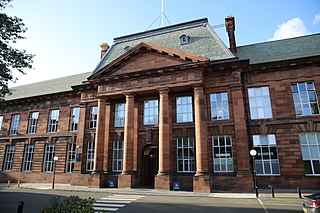
Edinburgh College of Art (ECA) is one of eleven schools in the College of Arts, Humanities and Social Sciences at the University of Edinburgh. Tracing its history back to 1760, it provides higher education in art and design, architecture, history of art, and music disciplines for over three thousand students and is at the forefront of research and research-led teaching in the creative arts, humanities, and creative technologies. ECA comprises five subject areas: School of Art, Reid School of Music, School of Design, School of History of Art, and Edinburgh School of Architecture & Landscape Architecture (ESALA). ECA is mainly located in the Old Town of Edinburgh, overlooking the Grassmarket; the Lauriston Place campus is located in the University of Edinburgh's Central Area Campus, not far from George Square.

Art Fund is an independent membership-based British charity, which raises funds to aid the acquisition of artworks for the nation. It gives grants and acts as a channel for many gifts and bequests, as well as lobbying on behalf of museums and galleries and their users. It relies on members' subscriptions and public donations for funds and does not receive funding from the government or the National Lottery.
The Glasgow School was a circle of influential artists and designers that began to coalesce in Glasgow, Scotland in the 1870s, and flourished from the 1890s to around 1910. Representative groups included The Four, the Glasgow Girls and the Glasgow Boys. Part of the international Art Nouveau movement, they were responsible for creating the distinctive Glasgow Style.

The King's Gallery, previously known as the Queen's Gallery. is an art gallery in Edinburgh, Scotland. It forms part of the Palace of Holyroodhouse complex. It was opened in 2002 by Queen Elizabeth II, and exhibits works from the Royal Collection.
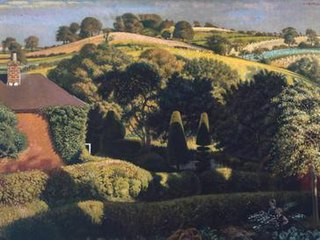
Douglas Percy Bliss was a Scottish painter and art conservationist. Bliss's family was of Northamptonshire, England. His grandfather moved to Moray, Scotland. Bliss himself was born in Karachi, India. Bliss was raised in Edinburgh and educated at George Watson's College from 1906–17. He always regarded himself as Scottish.

Wilhelmina Barns-Graham CBE was one of the foremost British abstract artists, a member of the influential Penwith Society of Arts.

Scottish art is the body of visual art made in what is now Scotland, or about Scottish subjects, since prehistoric times. It forms a distinctive tradition within European art, but the political union with England has led its partial subsumation in British art.
Gerard Baldwin Brown, FBA was a British art historian.

Humphrey Ocean is a contemporary British painter.

James Orrock R.I., R.O.I., was a prominent Scottish collector of art and oriental ceramics, illustrator and landscape watercolourist. The scale of his involvement with the art trade and with top collectors such as John Ruskin is highlighted in the large two volume set of books published about him by Byron Webber: published in London, Chatto and Windus 1903: James Orrock R.I., Painter, Connoisseur, Collector. Rather than being a forger as some modern scholars like to believe Orrock was a dedicated enthusiast of contemporary British art and emulated some of those artists in his own work. He illustrated three books in the style of Turner: Mary Queen-of-Scots, 1906; Old England : her story mirrored in her scenes, 1908; and, In the Border country, 1906.
Wendy McMurdo specialises in photography and digital media. In 2018 she was named as one of the Hundred Heroines, an award created by the Royal Photographic Society to showcase global female photographic practice.
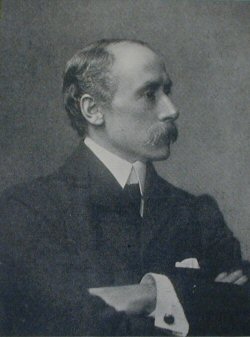
James Kay was a Scottish artist notable for his paintings of the landscapes and shipping around the River Clyde. Born on the Isle of Arran, Kay spent much of his working life with a studio in Glasgow and living at Portincaple on Loch Long in Argyll and Bute. He was elected to the Royal Scottish Society of Painters in Watercolour (RSW) in 1906 and to the Royal Scottish Academy in 1938. He had one daughter, artist Violet McNeish Kay.
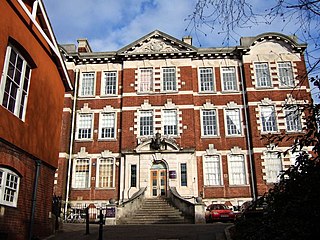
Exeter College of Art and Design was an art college based in Exeter, Devon. Founded in 1854, it amalgamated with what would become Plymouth University in 1989.
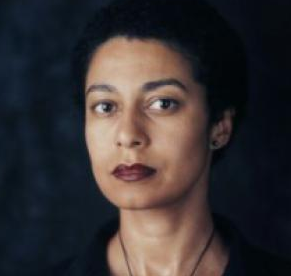
Maud Sulter was a Scottish contemporary fine artist, photographer, writer, educator, feminist, cultural historian, and curator of Ghanaian heritage. She began her career as a writer and poet, becoming a visual artist not long afterwards. By the end of 1985 she had shown her artwork in three exhibitions and her first collection of poetry had been published. Sulter was known for her collaborations with other Black feminist scholars and activists, capturing the lives of Black people in Europe. She was a champion of the African-American sculptor Edmonia Lewis, and was fascinated by the Haitian-born French performer Jeanne Duval.
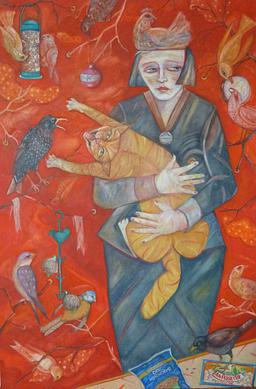
Joyce W. Cairns is a Scottish painter and printmaker based in Broughty Ferry, Scotland. In 2018, she was elected president of the Royal Scottish Academy (RSA).

William Brown Macdougall was a Scottish artist, wood engraver, etcher and book illustrator.

Art in modern Scotland includes all aspects of the visual arts in the country since the beginning of the twentieth century. In the early twentieth century, the art scene was dominated by the work of the members of the Glasgow School known as the Four, led by Charles Rennie Mackintosh, who gained an international reputation for their combination of Celtic revival, Art and Crafts and Art Nouveau. They were followed by the Scottish Colourists and the Edinburgh School. There was a growing interest in forms of Modernism, with William Johnstone helping to develop the concept of a Scottish Renaissance. In the post-war period, major artists, including John Bellany and Alexander Moffat, pursued a strand of "Scottish realism". Moffat's influence can be seen in the work of the "new Glasgow Boys" from the late twentieth century. In the twenty-first century Scotland has continued to produce influential artists such as Douglas Gordon and Susan Philipsz.
Gwen Hardie is a Scottish artist.
Stephen Dixon is a British ceramic artist and Professor Emeritus at Manchester School of Art. He is also a satirist, writer, lecturer and curator. He is known mainly for his use of dark narrative and for using "illustrated ceramics pots as an unlikely platform for social commentary and political discontent." From Renaissance paintings and British politics to pop culture, Dixon draws on a variety of sources to "challenge the status quo and inspire new ways of thinking." His interests include the British satirical tradition, commemorative wares, and the development of socio-political narratives in contemporary ceramics. In 2021 Dixon was awarded the prestigious British Ceramics Biennial AWARD for his installation 'The Ship of Dreams and Nightmares'.
References
- 1 2 3 "Alexander McNeish". Falkirk Community Trust Collection Online. Retrieved 6 December 2021.
- ↑ "Landscape on a Bar - Alexander McNeish". Google Arts & Culture. Retrieved 2 September 2020.
- ↑ "McNEISH Alexander b. 1932". www.artbiogs.co.uk. Retrieved 2 September 2020.
- ↑ "Biography". Rodick Carmichael. Retrieved 27 November 2020.
- ↑ Hair, Ross (1 January 2017). Avant-Folk: Small Press Poetry Networks from 1950 to the Present. Oxford University Press. ISBN 9781781383735 . Retrieved 28 September 2020.
- ↑ "Alexander McNeish - 1970's Scottish Abstract Painting Pinks and Blues". 1stDibs.com. Retrieved 2 September 2020.
- ↑ "Search the Collections". Manchester Art Gallery. Retrieved 2 September 2020.
- ↑ "Art UK". artuk.org. Retrieved 2 September 2020.
- ↑ "THE ORIGINAL SCOTIA NOSTRA – David Harding" . Retrieved 7 December 2021.